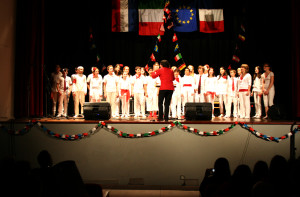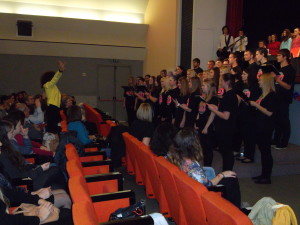Liceo Celio-Roccati’s
international activities in the last 5 years
Headmaster: Prof. ssa Joёlle ANNIBALINI
Coordinator: Prof.ssa Gabriella Osti
- Cultural exchange with I.E.S.Urola Ikastola Azkoitia/Azpeitia B.H.I. (Gipuzkoa) Basque Country – Teacher: Patrizia Muraca
- Cultural exchange with Charlemagne College, Landgraaf, The Netherlands Teachers: Gabriella Osti Donatella Cavallaro
Cultural exchange with Lyceum Feuchwangen-Germany – 16 students of German – Teacher: Nicoletta Bianco
- Cultural exchange with Lyceum Feuchwangen-Germany – 16 students of German – Teacher: Nicoletta Bianco
- The Liceo Celio’s Choir hosts the Choirs of “ Grotius College” from Heerlen-Holland and “Collège et Lycée Immaculée Conçeption” from Lyon-France, 18-21 November

- Cultural exchange with Azpeitia(Basque Country): 1st leg March in Spain, 2nd leg in Italy April. – A group of students of Spanish from year 4 – Teacher: Patrizia Muraca
- Comenius Project 2010-2012 “Young professionals research the future of their town” year 1.
Partner countries: Italy, Poland, Belgium, Germany, Turkey, Latvia, Spain.
EST project description:
The project “Young Professionals Research the Future of their Town” will stress the necessity to stimulate students’ scientific and creative activities in different areas. Students will have a chance to research the future of their native places through different school subjects and job shadowing. We plan to organize 6 sections which will work at the chosen theme connected with their native place The following sections will be formed in each partner school :
- young environmentalists will work at the theme “How to keep our environment clean”. This section will unite students who are interested in exact subjects – biology, chemistry, mathematics, physics
- young journalists will be responsible for revealing all the project activities in mass media. Their task will be interview participants, write articles and make video films.
- young linguists will research the impact of foreign languages on their mother tongue in their town
- young architects will design their future town taking into account the development tendencies in their place.
- young playwrights will create the play “The 21st Century School”. Partner schools will decide which genre each school will write and stage the play in.
- young ICT experts will investigate the means of communication in our modern society. The section will also be responsible for organizing project website and the work of section blogs.
Students and teachers will meet in on-line conferences to discuss the proceeding of the project.
The final product of the project can be found on the project platform http://hamburg.schulcommsy.de/commsy/commsy.php?cid=2164117&mod=home&fct=index where all the created materials ( presentations, plays, interviews, photos,
publications, project meeting timetables and resolutions, etc) are placed.
Project website to see all the produced materials: http://www.schulcommsy.de/wikis/276082/2164117/
Celio’s Choir visits “Collège et Lycée Immaculée Conçeption” Lyon-France
Cultural exchange with Feuchwangen-Germany – 16 students of German – Teacher: Nicoletta Bianco
Comenius project “Young professionals research the future of their town” year 2 (see above)
Comenius Project 2011-2013 “Promote your Euroregion” .Year 1
Partner countries: Italy (2 schools: Rovigo and Catania), Finland (Tornion), France (Bayonne,Basque Country)
EST project description:
Groups of teachers and students from several European schools have worked together to create promotional material of their own Euroregion in order to convince students from other parts of Europe to spend some time in their region in the way of holidays, studies or work. The definition of the term Euroregion has been defined by each school according to their local context and can refer to a EU state, a stateless nation, a region or contiguous territories located in different European countries with a transnational co-operation structure.
This project has implied:
- Research: “What is a Euroregion?” “How many do you know?” ….What could make your Euroregion a good destination?”
- A 3-step presentation of each group’s geographical historical and cultural identity through: school, town, region
- Construction of a blog on which all the produced material has been posted.
- Creation of facebook closed groups to help communication within single groups and between groups
- Design of promotional material: logos, videos, photos,power point presentations, mainly audiovisual materials
- Creation of a questionnaire and sharing of its answers aimed at mutually aiding each school to produce a virtual trip to the partners’ 3 regions.
- All virtual trips shown on a virtual google map in the blog.
- Proper use of the English language.
- Evaluation,modification and realisation of each project step
- Assessment and dissemination. Construction of final evaluation questionnaire and answers posted on the blog. What did we learn from our partners’ views on our Euroregion? What advantage can we take to improve our image?
- A competitive touch. Logo competition.
The following educational items are comprehended:
- English as a lingua franca.
- French, Italian,Basque,Finnish.
- ICT: Microsoft Office (Power Point), Google blog, Slideshare
- Active participation of the pupils
- Awareness of European diversity and citizenship
- Project materials to be seen at Project blog:
http://euroregions-comenius.blogspot.com
- Cultural exchange with Charlemagne College Landgraaf, The Netherlands, 17 students of English – Teachers: Donatella Cavallaro, Miriam Orlando.
- Cultural exchange with Feuchwangen-Germany. 1st leg (hosting phase in Italy) – 35students of German – Teacher: Nicoletta Bianco
- Comenius Project 2011-2013 “Promote your Euroregion”. Year 2 (see above)
- Cultural exchange with Charlemagne College Landgraaf, The Netherlands, 22 students of English – Teachers: Silvana de Vincentiis, Patrizia Muraca
- Celio Choir hosts 44 students of Lido Choir from Smiltene Lyceum- Latvia. October 27th-November 1st 2013 – Pictures of concert and exchange:
- Cultural exchange with Feuchwangen-Germany. 2st leg (Rovigo visits Feuchtwangen) – 35students of German – Teacher: Nicoletta Bianco
- Comenius project 2013-15 “Architectural cultural Heritage”.
Project description:
The participating students have been attending classes on cultural heritage in their environment.
The guiding teacher doesn’t need to have any specific knowledge. The student should be acquainted with the subject “rijksmonument” (state monument). Next to that the student will get information on paper from his coaching teacher. For foreign students there is an English translation.
With the help of an “observation guide” the students will investigate a building of cultural historic importance in their direct environment. They have to explain why they choosed this particular building; why this building important is to its environment; They have to gather as much data about the history and characteristics of this building.
The building must be on the state (or municipal) list of monuments. The choice is made by the student.
During the stay abroad students together with their partner-students from his host family, investigate a building of cultural historic significance. The building has to be selected in advance by the host student. He/she has done some investigations in advance in the same way their partners has done. The students inform each other “in sito” (on the site) about the building and take each other on a guided tour in and around the building. They have to fill in an observation guide.
They have to describe the cultural historic significance of this building, also its history. They have to explain why the building is relevant to its environment. They have to fill in the observation guide, to take some pictures of the building like: full shot of the exterior, the interior, relevant details. They have to take a picture together with their partner-student in front of the building.Together they have to make a PPT or Photo movie.
Project partners: Charlemagne College Landgraaf – The Netherlands, Liceo Celio-Roccati Rovigo – Italy, Istituto Comprensivo Danilo Dolci, Priolo Gargallo, Siracusa – Italy, I.E.S.Santa Maria La Real Aguilar De Campoo (Palencia)-Spain, NFGS Newport ,Saffron Walden – England.









